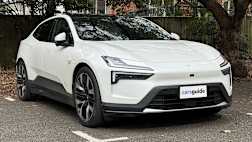Mitsubishi Australia has announced local details for the Eclipse Cross ahead of its December 22 launch, with the coupe-style SUV to start from $30,500 before on-road costs.
Two grades will be available initially, including the entry-level LS and range-topping Exceed – which kicks off from $36,000 – while a cheaper ES variant is projected to join the line-up in the future.
Standard equipment for the LS includes 18-inch alloy wheels with 225/55 tyres, LED daytime running lights, LED tail-lights, privacy glass, roof rails, rain-sensing wipers and dusk-sensing headlights.
.jpg)
Inside, a 7.0-inch touchscreen with 'Smartphone Link Display Audio (SDA)' multimedia system, touchpad and voice control, Apple CarPlay and Android Auto support, keyless entry and start, digital radio, fabric trim and an electric park brake with auto hold function feature.
Safety and driver assist features extend to seven airbags, auto emergency braking with pedestrian detection, forward collision warning, front and rear parking sensors, reversing camera, lane departure warning, high beam assist, adaptive cruise control and hill start assist.
The Exceed further adds dual-zone climate control, leather trim, auto-dimming rearview mirror, heated front seats, power driver's seat, auto-levelling LED headlights, double panoramic sunroof, fold-out colour head-up display, blind-spot monitoring, lane change assist, rear cross-traffic alert, 'Misacceleration Mitigation' and 360-degree cameras.
All Eclipse Cross variants are powered by the same all-new 1.5-litre turbocharged four-cylinder petrol engine, which produces 110kW of power at 5500rpm and 250Nm of torque from 2000rpm to 3500rpm.
A front-wheel drive (FWD) system can be had with either grade, while the flagship Exceed also has a 'Super All-Wheel Control (S-AWC)' all-wheel-drive (AWD) option that adds $2500 to its price, as well as three driving modes – 'Auto', 'Snow' and 'Gravel'.
No manual gearbox is on offer, meaning a continuously variable transmission (CVT) with an eight-step 'Sport Mode' manual override and paddle shifters is the sole choice.
Claimed fuel consumption on the combined cycle test is 7.3 litres per 100 kilometres for the FWD variants, which also have carbon dioxide (CO2) emissions of 165 grams per km.
Comparatively, the AWD variant drinks 7.7L/100km of petrol and emits 174g/km of CO2.
.jpg)
The European New Car Assessment Program (Euro NCAP) awarded the Eclipse Cross a five-star safety rating, with the Australasian New Car Assessment Program (ANCAP) expected to follow suit.
Slotting in between the compact ASX and mid-size Outlander, the Eclipse Cross aims to be a sportier offering in the compact-SUV segment while providing the practicality of a mid-sizer.
Measuring in at 4405mm long, 1805mm wide and 1685mm tall, the Eclipse Cross is 50mm longer, 5mm wider and 45mm taller than the ASX, while both models share the same 2670mm wheelbase.
The Eclipse Cross rides on MacPherson struts at the front and a multi-link set-up at the rear, which Mitsubishi claims "have been developed for handling precision, concerning performance and ride comfort".
The new SUV also features an adjustable 60/40-split rear bench that can slide by 200mm and recline by 16 to 32 degrees.
Mitsubishi will be hoping the Eclipse Cross replicates the sales success of its ASX sibling, which currently leads the compact SUV under $40,000 segment this year, with 15,327 examples sold to the end of October, up 1.4 per cent year-on-year.
Other contenders in the class include the Mazda CX-3 (14,799), Nissan Qashqai (11,244), Honda HR-V (9841), Subaru XV (7954), Holden Trax (6319), Suzuki Vitara (4985) and Toyota C-HR (4869).





.jpg)

.jpg)


_0.jpg)
 (1).jpg)

.jpg)
.jpg)
.jpg)


.jpg)
.jpg)
.jpg)
.jpg)



.jpg)



.jpg)